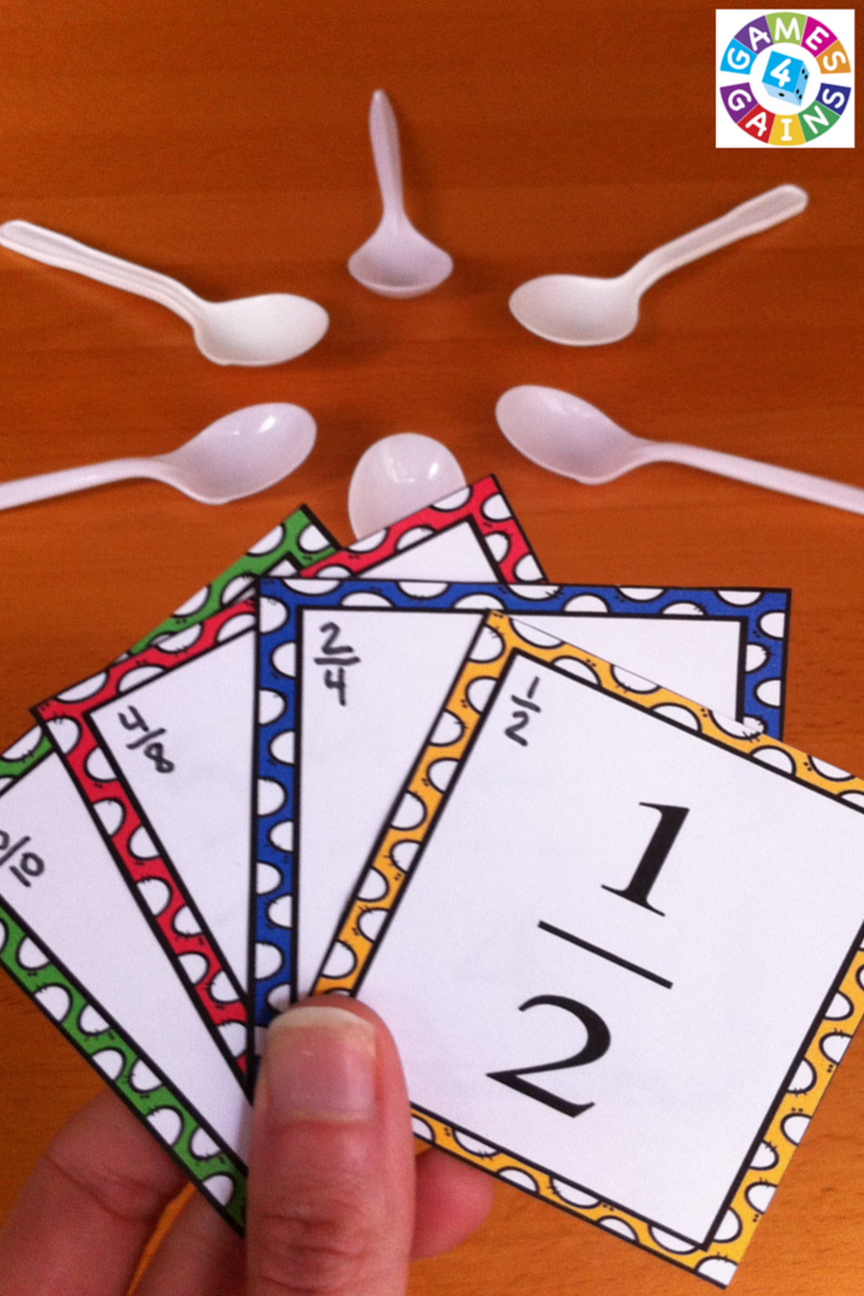JUGAMOS EN LA PIZARRA DIGITAL
CON LAS FRACCIONES EQUIVALENTES
trabajamos en la pizarrilla digital
GRUPO 2
EQUIVALENT FRACTIONS GAME OF 'SPOONS'
Posted by Brittney Field on Aug 27, 2015

This game for practicing equivalent fractions is a variation on the classic card game "Spoons." If you've ever played "Spoons" before, you know that the game is super fast-paced and lots of fun. I figured that if I could combine the fun and exciting parts of "Spoons" with some equivalent fractions practice, I'd have a center game that my students would be dying to play. And let me tell you, this one does not disappoint!
How to play Equivalent Fractions "Spoons":
Number of players: 3-6 players
Preparing the materials:
1. Print out the Equivalent Fraction cards that we've created for this game by CLICKING HERE. Cut out each of the cards.
2. Grab some plastic spoons (or any other object that can be grabbed by the players). You need one fewer than the number of players. For example, if you have 6 players, you'll need 5 spoons.
Object of the game:
To be the last player remaining in the game. Players get closer to being eliminated each time they are left without a spoon, which earns them the next letter in the word S-P-O-O-N. Once a player has earned all 5 letters in the word S-P-O-O-N, he or she is out.
Getting ready to play:
1.Arrange the spoons in a small circle in the center of the table.
2.Shuffle the equivalent fraction game cards and deal four cards face down to each player. The players may look at their own cards, but may not show their cards to anyone else.
3.Choose a dealer for the round. The remaining cards should be placed in a pile facedown beside the dealer.
Playing the game:
1.The dealer takes a card off the top of the pile so that he or she now has five cards in his or her hand. The dealer removes one of the five cards from his or her hand and passes it facedown to the player on his or her left. The dealer then continues to pick up cards from the pile and discard one card at a time to the player on his or her left.
2.The player to the left of the dealer picks up the discarded card from the dealer. Like the dealer, he or she removes one of the five cards from his or her hand and passes it facedown to the person on his or her left. He or she continues to do this as cards continue getting discarded to him or her.
3.This quick picking up and passing of cards continues around the circle. The last player in the circle always places his or her discarded card into a trash pile. These cards are now out of play for the round.
4.Once someone gets four-of-a-kind (four fraction cards that are equivalent makes four-of-a-kind) in his or her hand, he or she grabs a spoon from the center of the table. Once the player with four-of-a-kind takes a spoon, everyone else tries to immediately grab a spoon (even if they do not yet have four-of-a-kind).

5.The player left without a spoon earns a letter in the word S-P-O-O-N.
6.The round is now over and the game begins again. If any players were eliminated during the last round, a spoon must be removed so that there is always one fewer spoon on the table than players.
Did your students enjoy playing this game? We'd LOVE it if you'd share one of these images on social or leave a comment in the space below!


GRUPO 3
EL RECORRIDO DE LOS FACTORES
Observaciones:
Sacado de una colección de juegos en http://illumination.nctm.org, propuestos por el National Council of Teachers of Mathematics (NCTM), presentamos un recorrido a efectuar sobre un tablero, a lo largo del cual, los jugadores deben hallar todos los factores de los números que aparecen en las casillas del recorrido.
Objetivos:
– Reforzar el concepto de divisor y factores de un número.
Nivel: Primaria- 1º-2º de ESO
Material necesario:– Un tablero. /- Unas tablas para las puntuaciones./- Un dado.
Finalidad del juego:
Saliendo de la casilla Salida, llegar al Final por el tablero del juego.
Reglas del juego:
– Juego para dos jugadores.
– El primer jugador tira el dado y se mueve desde la salida las casillas correspondientes al resultado del dado. Al llegar a una bifurcación (con 24 y 72) se debe escoger alguno de los dos recorridos que aparecen.
– Al llegar a una casilla, el jugador debe hallar todos los factores del número de la casilla.
– Si lo hace correctamente, obtiene como puntuación la suma de todos los factores. La puntuación se debe inscribir en la tabla de puntuación del jugador.
– Si el jugador se equivoca, diciendo un factor que no lo es o olvidándose de algún factor, no puntúa, marcando un cero en la columna de puntuación de su tabla.
– Si el adversario encuentra un error, obtiene 10 puntos por cada uno.
– A continuación, el segundo jugador repite lo mismo.
– Cuando un jugador llega a la casilla FINAL, se acaba el juego.
GANA EL JUGADOR QUE HA OBTENIDO MÁS PUNTOS
Para llegar al final, no es necesario obtener el resultado exacto sino que se puede rebasar, quedándose en la casilla FINAL. Por ejemplo si el jugador está en la casilla 98 y saca 5 con su dado, ha llegado (con creces) al FINAL.
Descarga aquí la actividad para los alumnos: Recorrido de los factores alumnos
Descarga la actividad para el profesor: Recorrido de los factores profesor
Descarga el tablero del juego: TABLERO
GRUPO 4







0 comentarios:
Publicar un comentario